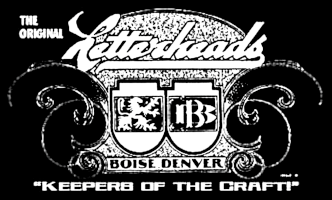My name is Josh Gray. I'm new to the forum and new to the techniques discussed here. I have a photography background, and have been etching glass with a sandblaster for a couple of years.
I have been reading and learning about glass work for a few months now (on this forum and elsewhere -- a big thanks to all who share & participate!), and finally had the chance to try some basic techniques. So here goes my experience with glue chip and silvering my first mirror...
Material list included 192 gram strength glue (a little stronger than the recommended 165), glue pot, a sheet glass mirroring kit from Angel Gilding, and a piece of regular 1/4" glass; 14" x 22" (the largest that would fit in the mirroring kit tray).
First off, I masked the glass with vinyl and sandblasted using 120 grit aluminum oxide. I blew the glass off with air, rinsed in water with a quick brush scrub, and leveled the glass and applied the glue with a turkey baster. Waited for the glue to gel, and then trimmed with an exacto knife. I did not use asphaltum ... I just left the vinyl mask on.
I waited overnight, and then placed the glass in the sun the next morning. The glue chipped leaving several unchipped areas, especially along the crucial trimmed edges. After a long sigh, I decided that perhaps I better slow down and not be in too big a hurry.
I then repeated the glue application, but this time pre-heated the glass before applying the glue. I also let the glue air dry 1-1/2 days before trying to chip. It was overcast outside, so I assembled a make-shift drying rack in the garage and chipped the glass there. I placed the glass on two saw horses with a card table on top, a tarp draped overall, and an electric ceramic heater underneath for heat.
The results were great, especially around the trimmed areas I was so worried about. BUT there were still a couple of small spots that I wanted chipped ... so I fired up the pot and spot-glued these areas, applying the glue with an eyedropper. Didn't bother trimming the glue this time. I was finally satisfied with the chip after this last attempt.
Through research on this forum and a quick note to Sarah at Angel Gilding, I learned I needed to add an extra cleaning step since I use Aluminum Oxide (it will discolor the silver). No problem ... just gotta clean with a lye solution to dissolve any residue. I soaked the glass in some Red Devil drain cleaner for about an hour. Drano will also work ... it's just gotta have Sodium Hydroxide (lye).
Now I was ready to clean the glass and apply the silver. While reading the silvering instructions and noting how surface tension plays an important part, I was a little worried about chipping to the edge of the glass. This worry was for good reason, because I found the chipping complicates the rinsing process.
I proceeded as per directions to the point of mixing the three silvering chemicals, where-upon the combined solution quickly changed from yellow to dark grey
I took a deep breath and poured anyway.
The silver almost immediately started to deposit on the glass. It was a pretty sight
Gotta realize that, up until that point, I had only seen pictures of gilded glue chipped glass ... so it was really magical to finally see in person. I was/am amazed at how every tiny detail is magnified by the silver.
Overall, I could see a few problem areas in the silver deposit ... a big starburst in the middle, and some bare patches along the edge of the glass where it was tipped for draining (must not have rinsed/drained well enough?). So after the prescribed 5 minutes was up, I rinsed very well -- paying particular attention to the bottom drip edge -- and applied the second batch of silver that was already mixed and ready to go. The silver deposited fine this time.
Dried the glass with a hair dryer and painted the back without incident (something could have gone wrong, right?!).
Turned the glass over for a good look and found a pretty good antique-looking mirror staring back
There is a faint starburst in the center (I poured around the edges first) and a few slight discoloration spots.
I checked with Sarah about why the chemicals changed a dark grey so fast, and she said heat can do it. The chemicals are made to be used at room temperature. Heat speeds up the reaction.
Yeup, it was 95 that day, and I was working in an open garage.
In conclusion, I have some experimenting to do in order to master a crisp, bright silver. I'm hopeful that the hot temperature was the main culprit in my silvering problems. Anyone else ever had this problem?
Cheers!
Josh
 Denver Chapter of the Letterheads
Denver Chapter of the Letterheads